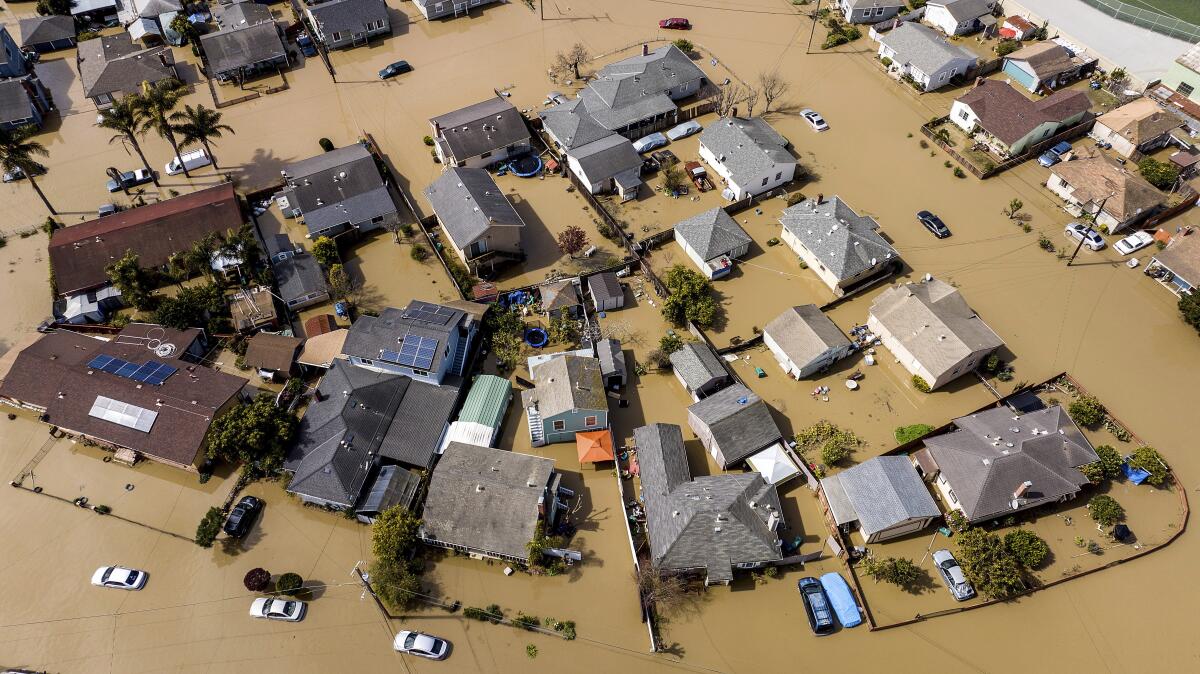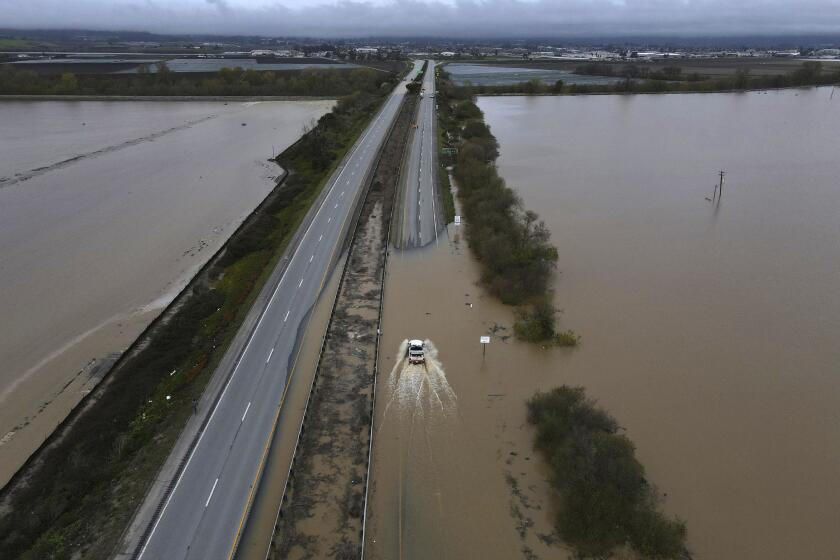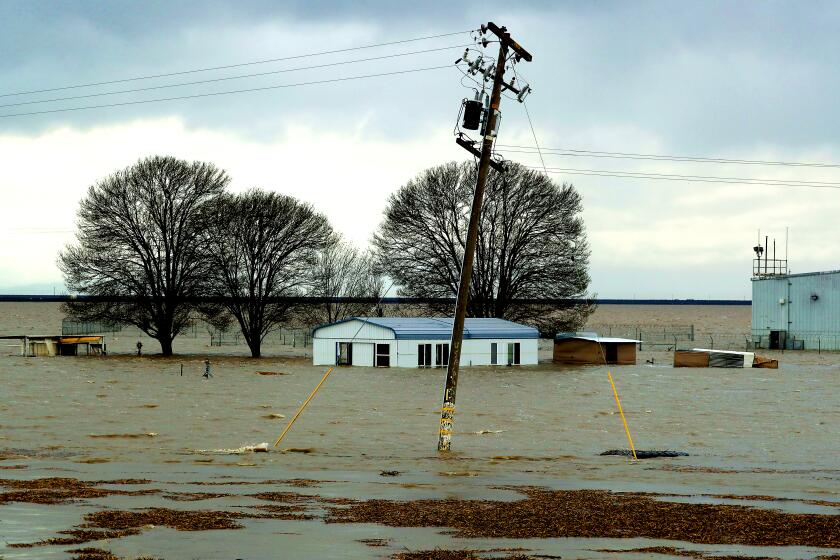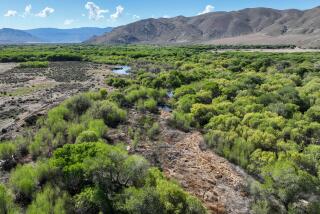Opinion: Catastrophic floods and breached levees reveal a problem California too often neglects

For much of the past decade, Californians have been fixated on drought, and rightly so. But the flipside of the state’s volatile climate returned this year, reminding us that “normal” in a land of extremes can be either very wet or very dry.
A dozen or more atmospheric rivers have caused more than $5 billion in damage in the state, with more damage expected when the Sierra Nevada snowpack melts in the coming weeks. State, federal and local governments need to give the risk of such floods the kind of attention we give droughts for several reasons.
First, the potential economic damages of large floods well exceed those of droughts. And floods can be lethal.
In the Los Angeles Basin alone, almost half a million people live in areas at high risk of flooding, with more than $50 billion worth of property exposed to even a modest flood. The damages of a very large, statewide flood — like the floods of 1862 — would exceed $1 trillion.
Second, the climate shift that is making droughts more intense will also boost the intensity of winter storms, increasing flood risks.
Third, as recent work at UC Irvine has shown, flood preparedness efforts tend to focus narrowly on meeting the bare-minimum federal standards — standards few floodplain managers consider adequate. This approach vastly underestimates the magnitude of flood risks.
Official floodplain maps are either out of date or inaccurate, and they fail to account for the changing climate. Our flood management infrastructure, meanwhile, is aging: Most of California’s levees, dams, coastal protections and flood walls and channels are more than 75 years old.
Finally, flood management is a social justice issue. As the recent levee failures on the Pajaro River showed, low-income communities that lack resources for flood protection and recovery are especially vulnerable. The UC Irvine study demonstrated that the L.A. region’s flood risk falls disproportionately on low-income, predominantly Black communities. Federal flood risk assessment methods help perpetuate these patterns because they favor solutions that protect the most valuable properties.
For years, experts had been warning Monterey and Santa Cruz County that the levee along the Pajaro River could fail.
How do we turn things around? Putting flood management on par with drought management will require addressing several big issues.
First, we need to identify the risks and appropriate responses more accurately with our changing climate in mind. Communities and governments need to work together to increase resilience, particularly for the most vulnerable populations. The state can get ahead of the federal government by promoting innovative ways of assessing risks and funding disaster insurance.
The same risk assessments can be used to guide land use. The most cost-effective risk management strategy is to discourage new construction in areas at high risk of flooding. In the Central Valley, the state Legislature has recognized that by requiring a level of urban flood protection that is higher than the minimum federal standard.
Second, all levels of government must renew investment in aging and inadequate flood management infrastructure. This has been recognized as a top priority by the Newsom and Biden administrations, the state Legislature and many local governments, but substantive action and a long-term funding plan are still needed.
As PPIC reports have highlighted, flood control is often a “fiscal orphan,” with constitutional restrictions making it difficult to raise local funds for the needed infrastructure. The good news is that more than $700 million in one-time state funding is available for flood improvements this fiscal year. That will help, but it’s only about half what the state should be spending every year just to keep pace with the need.
Floods have revived a ‘phantom lake’ in the San Joaquin Valley, but the shallow inland sea has defined the region for decades.
Finally, flood and drought management should be integrated for maximum efficacy. That means using floodwaters to recharge groundwater basins; making more room for rivers to accommodate floods and improve ecosystems; adding more green spaces to our cities to provide shade during heat waves and absorb runoff during storms; and employing new technology to ensure reservoirs provide both water supply and flood control. Innovations like this are starting to occur across California, but they need to be scaled up to help us manage flood risks while also getting us through dry times.
There’s room for optimism about the benefits of linking flood and drought management. Much of our aging flood infrastructure was not designed for water supply but rather to sweep water quickly to the ocean. Communities that start to make flood infrastructure a more integral part of their water supply planning can address both problems.
California has a right to be obsessed with drought. But that obsession must not lead us to neglect the threat of floods, which pose such high risks for human safety and the economy. The storms of the past winter, and the snowmelt-fueled deluges we can expect this spring, are a reminder that we should be equally preoccupied with floods.
Jeffrey Mount is a senior fellow at the Public Policy Institute of California’s Water Policy Center. Brett Sanders is a professor of civil and environmental engineering at the Samueli School of Engineering at UC Irvine.
More to Read
A cure for the common opinion
Get thought-provoking perspectives with our weekly newsletter.
You may occasionally receive promotional content from the Los Angeles Times.












